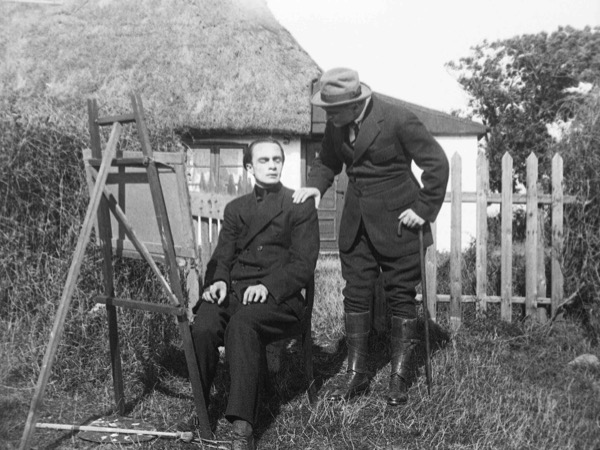DER GANG IN DIE NACHT
(Love’s Mockery) [Il cammino nella notte]
Friedrich Wilhelm Murnau (DE 1920)
The earliest surviving film directed by Murnau anticipates themes from his later masterpieces: a siren’s attempt to seduce a man away from his ordered world, as in Sunrise; the contrast between the city and the countryside; Conrad Veidt’s stylized portrayal of a blind man, which seems to prefigure Max Schreck’s performance as the vampire in Nosferatu. Carl Mayer’s screenplay discloses the narrative through a series of scenes in the Kammerspiel style. Murnau’s skilled direction manages to seamlessly bridge the temporal ellipses, while at other points stretching the time out, as during the film’s dramatic climax in the third act, which unfolds in near real-time.
Considered at the time to be something of an experiment, the film was hailed in Der Kinematograph (no. 728, 30 January 1921) as “the first example of a new level of film art.” Immediately after the press screening, film critic Willy Haas (who would later write the screenplay for Murnau’s Der brennende Acker) raved in his review for Film-Kurier (no. 277, 14 December 1920): “Where does the art of the writer end, and the art of the director and the actors start? One doesn’t know. Everything is intertwined. Everything is – there’s no better word for it – complete. Carl Mayer wrote the script – nothing less than a work of poetry. The film follows his words painstakingly. Unbelievable how he rushes through passages, pressing, breathless, with just two indications. Wonderful how he knows at other times when to pause, easy, almost persistent, as when the lights of cars reflect on the rain-soaked asphalt of the big city [streets], or when the sea churns or the pale sun rises – how he repeats passionately again and again throughout the story: ‘Dear spectator, this belongs in the film, it is part of the storyline.’ Or how he invents elegant flourishes – like the scene with the wounded foot of the woman who is supposedly a farmer – and one can feel the dainty air of creativity. Or when he lets the woman confess to her husband that she is in love with another man: three words, then she bows over his hand – nothing more. All these moments are unforgettable, as simple and inexplicable as life itself, as casual and tirelessly convincing as fate.”
According to Lotte Eisner, Henri Langlois discovered the original nitrate negative of the film, which since 1945 was believed to be lost, at the Staatliches Filmarchiv der DDR (the state film archive of the German Democratic Republic), and had a new print struck. However, the negative was incomplete: there were no titles present and Reel 3 was missing in its entirety. The film was shown in this mutilated form throughout the 1960s and 1970s, until Enno Patalas learned that the negative had been copied at Gosfilmofond in Moscow prior to being sent to the GDR, and at that time it had still contained the third reel. Using parts of Murnau’s personal copy of the shooting script, then still in the possession of his heirs, Patalas spliced newly created intertitles into a print he received from Gosfilmofond. Unfortunately, Murnau changed a number of details during the filming and completely rewrote the ending of the film. Thus, the precise number of intertitles and their wording could only be speculated.
The new digital restoration by the Munich Film Museum draws directly on the original camera negative, now held at the Bundesarchiv, as well as on the workprint edited by Enno Patalas and Murnau’s complete shooting script, which is now held at the Deutsche Kinemathek. By studying these materials intensively and comparing them with existing contemporary reviews from newspapers and magazines, slight corrections could be made to the editing as well as to the frequency, position, and wording of the intertitles. The colour tints and the font of the intertitles were reconstructed following the conventions of the time. Scanning and picture restoration were carried out by Thomas Bakels, while Christian Ketels performed the colour grading and editing. Richard Siedhoff, who was involved in the restoration process, has composed both a new piano soundtrack as well as a full orchestral score. Historian David Bordwell has rhapsodized about the experience of seeing the new restoration: “The Munich Film Museum’s team has created one of the most beautiful editions of a silent film I’ve ever seen. You look at these shots and realize that most versions of silent films are deeply unfaithful to what early audiences saw. In those days, the camera negative was usually the printing negative, so what was recorded got onto the screen. The new Munich restoration allows you to see everything in the frame, with a marvelous translucence and density of detail. Forget High Frame Rate: This is hypnotic, immersive cinema.”
Stefan Droessler

scen: Carl Mayer, based on a script by Harriet Bloch.
photog: Nax Lutze.
scg/des: Heinrich Richter.
cast: Olaf Fönss (Eigil Boerne), Erna Morena (Helene), Conrad Veidt (il pittore cieco/a blind painter), Gudrun Bruun-Steffensen (Lily), Clementine Plessner.
prod: Goron-Films.
dist: Progress-Film GmbH.
uscita/rel: 21.01.1921, Berlin (Schauburg).
v.c./censor date: 20.10.1920 (B.00616).
copia/copy: DCP (da/from 35mm, orig. 1927 m.), 81′ (trascritto a/transferred at 21 fps), col. (imbibito/tinted); did./titles: GER.
fonte/source: Filmmuseum München.
Restauro/Restored: 2016.


 Italiano
Italiano